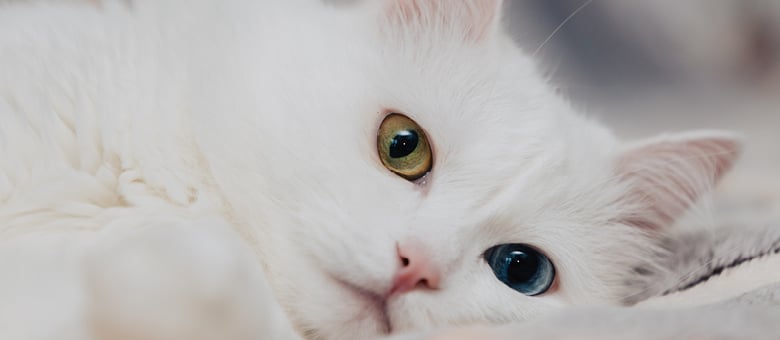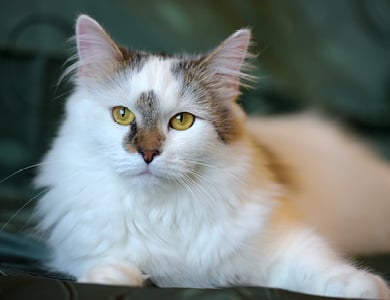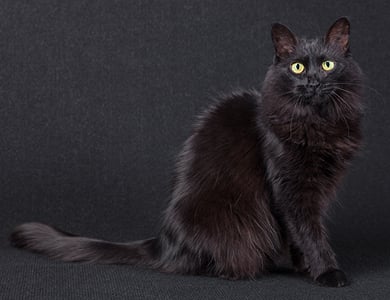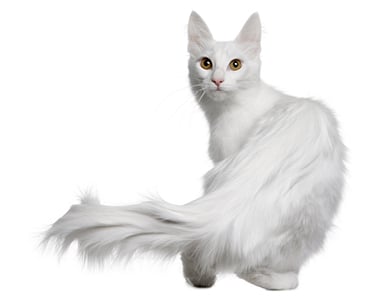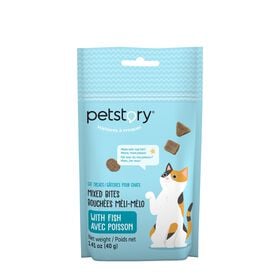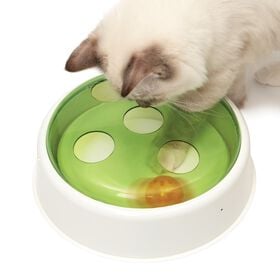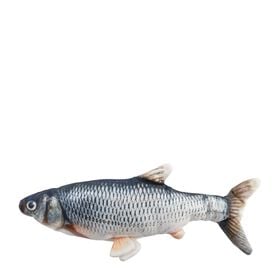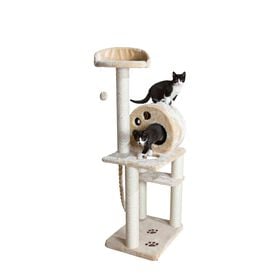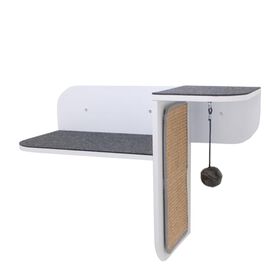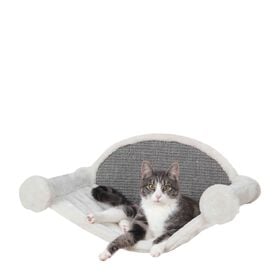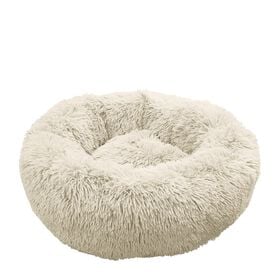Slim and athletic, with a beautiful coat, the Turkish Angora is often compared to a ballerina. Originally, its coat was always white. Although the Turkish Angora’s possible coat colours have changed, the breed is still believed to be the origin for white coat colour and long hair in domestic cats. The Turkish Angora is also referred to as the Angora or Ankara cat (be careful not to confuse it with the Turkish Van).
Morphology and appearance
When describing the Turkish Angora, the word “elegance” comes to mind immediately. It has a medium-size, slender body. It is a fine-boned cat with long legs that end in small round to oval paws that are tufted between the toes. Its rather small head is triangular when seen from the front, while its profile forms two straight planes meeting at a very open angle above the eyes. Its ears, wide at the base and pointed, sit high on the head and are heavily tufted, with additional tufts at the tips known as “lynx tips.” Its large, almond-shaped eyes slant slightly upward and are very expressive. Colours include blue, green or amber. The cat may also be odd-eyed (with two different coloured eyes).
Although slender, the Angora has an athletic build concealed by a luxurious, silky, fluffy coat that makes the cat seem bigger than it really is. As the medium length fur grows, it becomes thicker around the ruff, britches and belly, where it tends to crinkle. White is the iconic colour of Ankara cats and was, for a long time, the only colour within the breed. Today, however, Angoras come in practically every colour, except lilac, cinnamon, chocolate and fawn. The colourpoint, sepia and mink patterns are not accepted since they are signs of crossbreeding.
Last, but certainly not the least of the Turkish Angora’s characteristics is obviously the tail. Like the rest of the cat, it is particularly elegant, resembling ostrich feathers. The plumed tail is carried upright, perpendicular to the back.
Level of maintenance (grooming)
The Turkish Angora has practically no undercoat and its coat rarely mats. Regular brushing is recommended, especially to keep the coat silky and shiny. Since the fur of this magnificent cat is thicker in winter than in summer, the Angora can lose a great deal of hair during shedding seasons. Brushing will help reduce hairballs and minimize the amount of hair on the sofa.
Behaviour
The vast majority of Turkish Angoras are lively, curious and affectionate, and love being close to humans. They enjoy playing, and will continue to do so all their lives if they are encouraged. They love perching on high places, such as a cat tree, on top of furniture or even on their owner’s shoulders. They like to please and are quick learners. Many become excellent candidates for learning tricks. Obviously, this description is not exhaustive, and each individual is entirely unique, with its own distinctive characteristics. It is therefore important to find out about the personality of the cat you want to adopt to be sure that it suits your lifestyle.
Origins
The Turkish Angora has been around for more than 2,000 years and it can be found in works dating back to the start of the Roman Empire. It is a natural breed, meaning that it came about naturally, following a spontaneous genetic mutation (long hair) that spread throughout the local domestic cat population, in Turkey, but also in countries in the Near and Middle East.
In the 17th century, the first specimens were brought to Europe. Since they originated in the Turkish capital region, historically known as Angora (today, the capital of Turkey is Ankara), they were given the name Turkish Angora. At the time, European cats were all short-haired. The Angora quickly became wildly popular among the European aristocracy. In France, in particular, a Turkish Angora sat at the table of the Council of King Louis XV. Cardinal Richelieu had as many as fourteen of these cats, and it is said that Marie-Antoinette had six Turkish Angoras, which she apparently sent to America before being arrested.
In the 19th century, the Persian cat was developed from Turkish Angora mutations by British cat fanciers. The Angora was quickly surpassed in popularity by the Persian, and almost became extinct in Europe. However, Turkey considered the breed a national treasure, and efforts were made to ensure the preservation of the precious long-haired white cats. In the early 20th century, a breeding program was established at the Ankara Zoo, and exports were forbidden. Cats were chosen for the program only by their colour (white); no other criterion was used. The zoo also prized odd-eyed cats. Despite everything, Ankara Zoo cats all had the same characteristics: those of the Ankara cat.
Toward the mid-20th century, the Ankara Zoo allowed an American couple to have a male named Yildiz and a female named Yildizcek. The breeding of Turkish Angoras once again took flight, this time in the U.S. Other Ankara Zoo cats were then added to the breed’s gene pool in North America and Europe. Until 1978, only the white coat was recognized. To help increase the gene pool and limit problems related to the gene for white fur, colours were expanded within the breed. In Turkey, the breed is still protected and it is possible to see Turkish Angoras when visiting the Ankara Zoo.
Unusual facts
- The Turkish Angora is the source of all long-haired (Persian) and mid-long (Maine coon, Norwegian) breeds present in Europe and America.
- The adjective “Angora” has been attributed to a number of other animals to refer to their long, very soft fur. The most well-known, the Angora rabbit and the Angora goat, also originated in Turkey.
- The Turkish Angoras bred in Europe and America seem to have evolved quite differently, and today form a genetically distinct population compared with the Turkish Angoras at the Ankara Zoo.
- White Angora kittens can be born with one or more grey spots on their head and between their ears that disappear within the first year of life.
- The gene for white fur (the white gene is in truth the absence of colour) and blue eyes is closely related to the cat’s hearing ability. A white cat with blue eyes will therefore have a greater risk of being completely deaf. Similarly, a white cat with one blue eye and one eye of another colour may be deaf on the side of the blue eye. However, many blue- and odd-eyed cats have normal hearing, and even deaf cats can lead a normal life and be excellent pets.
